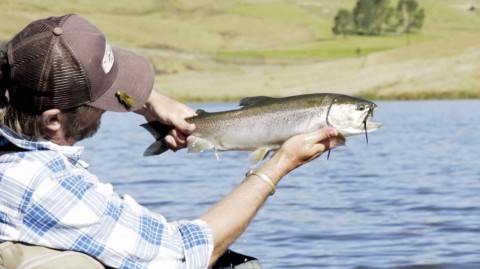CHEERS | FISHING

Of floats
and flies
Gareth George once again muses about all things fly fishing –whether from adjacent to the water or actually in it.


Caught on an ‘infallible fly’, a beaming Gareth George shows off the spoils

Jeremy counters with one of his own

As the sun climbs higher, trout withdraw to deeper waters. A float tube allows fishermen to access them from a different angle

The size of the smile is proportionate to that of the trout

Fish sheltering in reed and weed beds can be approached from open water with the right equipment
To many a gentleman fly fisher, floating on a lake or dam while in a tube is akin to replacing a chess set with checkers pieces. It’s still a board game but it lacks the same strategy, finesse and skill – or that’s what so many traditionalists would have you believe.
But is it legalised trawling?
Gently finning with your line in the water is how you get from bank to bank and anyone who claims they have not caught a trout in this fashion is guaranteed to have me raising an eyebrow about the veracity of any of their fishing tales. Yet, to aimlessly kick around a dam will generally frustrate you and your fellow anglers and yield not much more than severe hamstring cramps.
A V-Boat or float tube definitely makes the job of catching trout significantly easier, not to mention infinitely more comfortable, but the fact that you can access so much more of the dam calls for a well-planned strategy.
Decision number one is when to tube. Dawn and dusk are when you don’t need to launch because that’s when the trout are in the upper reaches of the water column anyway, often patrolling the shoreline. This period of low light makes them less vulnerable to predators.
Once the sun is higher overhead and you’re afloat, the judgment becomes where to focus one’s effort.
Trout, like any other resident fish, are structure orientated, so ideally casting should be into this structure rather than being above it. Positioning yourself off solid weed beds and bank, working your fly around the shelter and food source will deliver rewards.
But what fly to use? I’ve had a recent epiphany.
After countless hours of fumbling at the vise and enduring ridicule at my imitations from fishing brethren, I finally tied the definitive pattern. It had the right weight, perfect colour combination and it moved like a distressed damsel begging for rescue.
In a single day, it accounted for more takes, charges and catches than I can recollect. Consequently, I announced to my cabal of envious detractors that I’d cracked the code. “Pack away your fly boxes with such pitiful imitations and pay attention!”, I preached.
It not only looked the part, but the proof was in my trout pudding. The triumphant pictures circulated faster than the latest Eskom load shedding schedule. I have seldom had such satisfying sleep.
After toying with the idea of applying for an honorary appointment to the International Fly Tyers guild, I was back on the water the following day, dispensing advice to fishing buddy Jeremy.
And I patiently waited until he had landed another half a dozen fish before indulging in a big slice of humble pie.
“What’s the fly?” I grudgingly asked.
As with most trout or even salmon fly acronyms, the MGB will mean nothing to the layperson. But it was what he was using to humble me and teach me a lesson in pride coming before a fall. I managed a trout or two on my new ‘infallible’ pattern but was properly whipped and suitably contrite.
After much conferring, we both noted that regardless of pattern, the majority of trout were charging at the fly on the hang or when we induced the take. This was done by just lifting the rod, right at the end of the retrieve, bringing the fly up through the water column. The fish were chasing and smashing it right on the surface.
This was especially apparent when fishing into a weed bed, inaccessible from the bank.
My preference will always be casting from terra firma but to not have a float tube when exploring a dam is really handicapping yourself.
And I’ve also realised that you never really invent a fly pattern; you simply build on another’s foundation, stealing good ideas and giving them your own personal twist. Thankfully fly patterns can’t be patented!